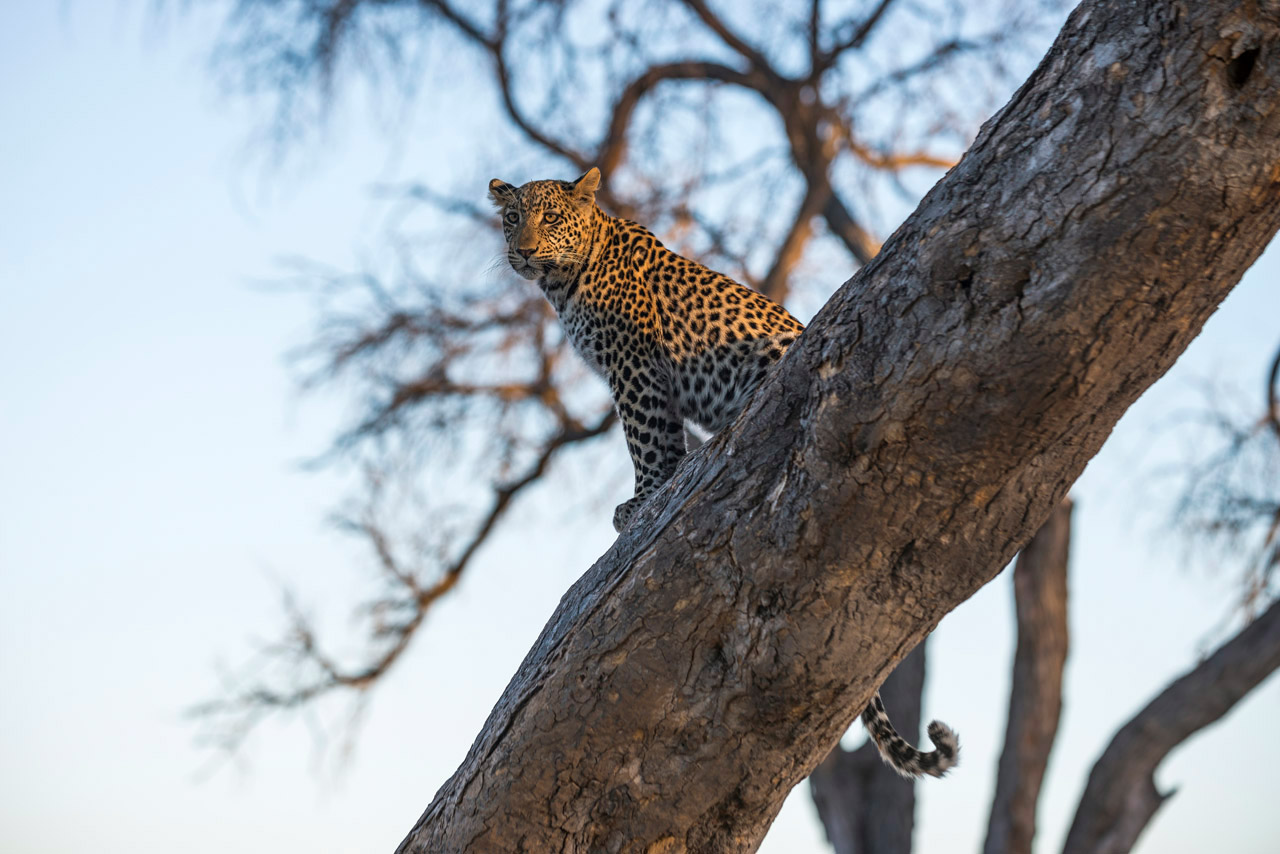
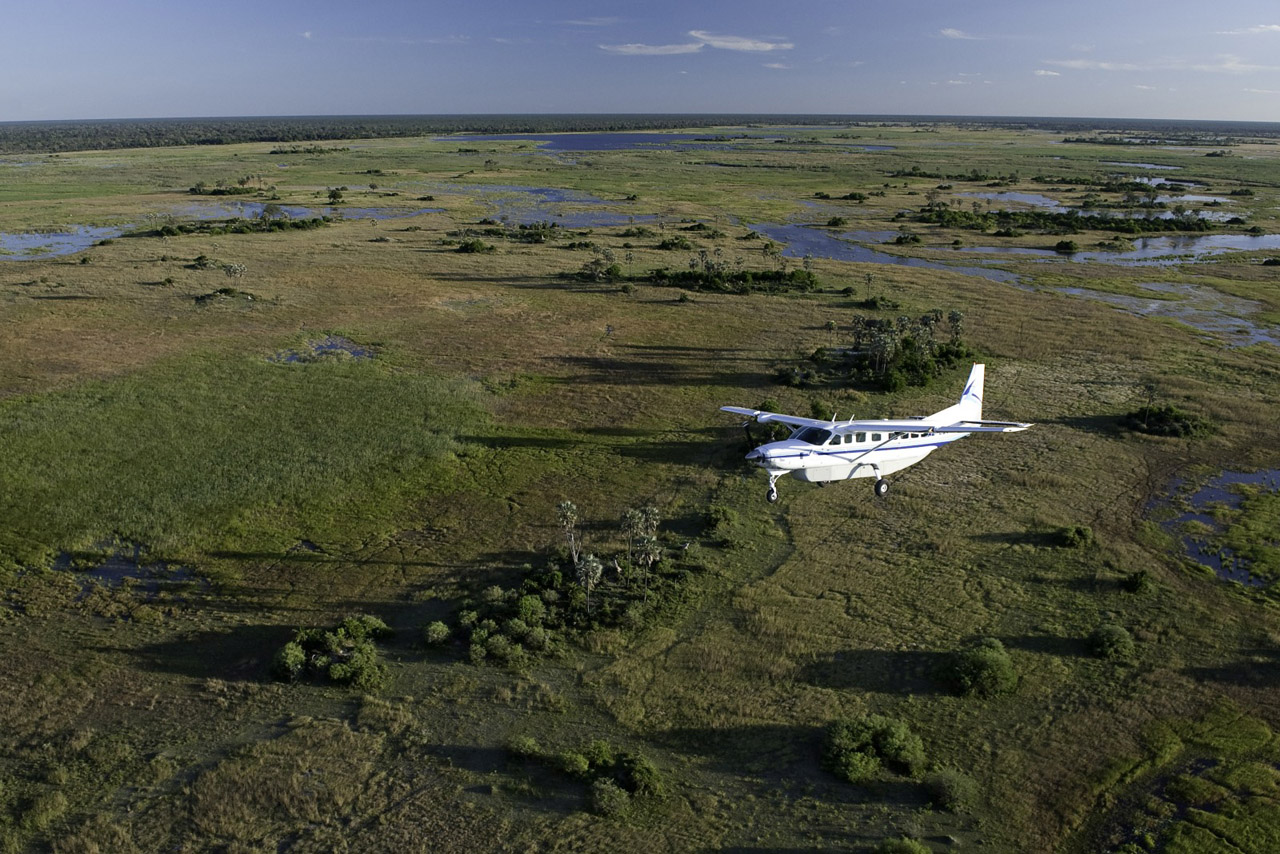

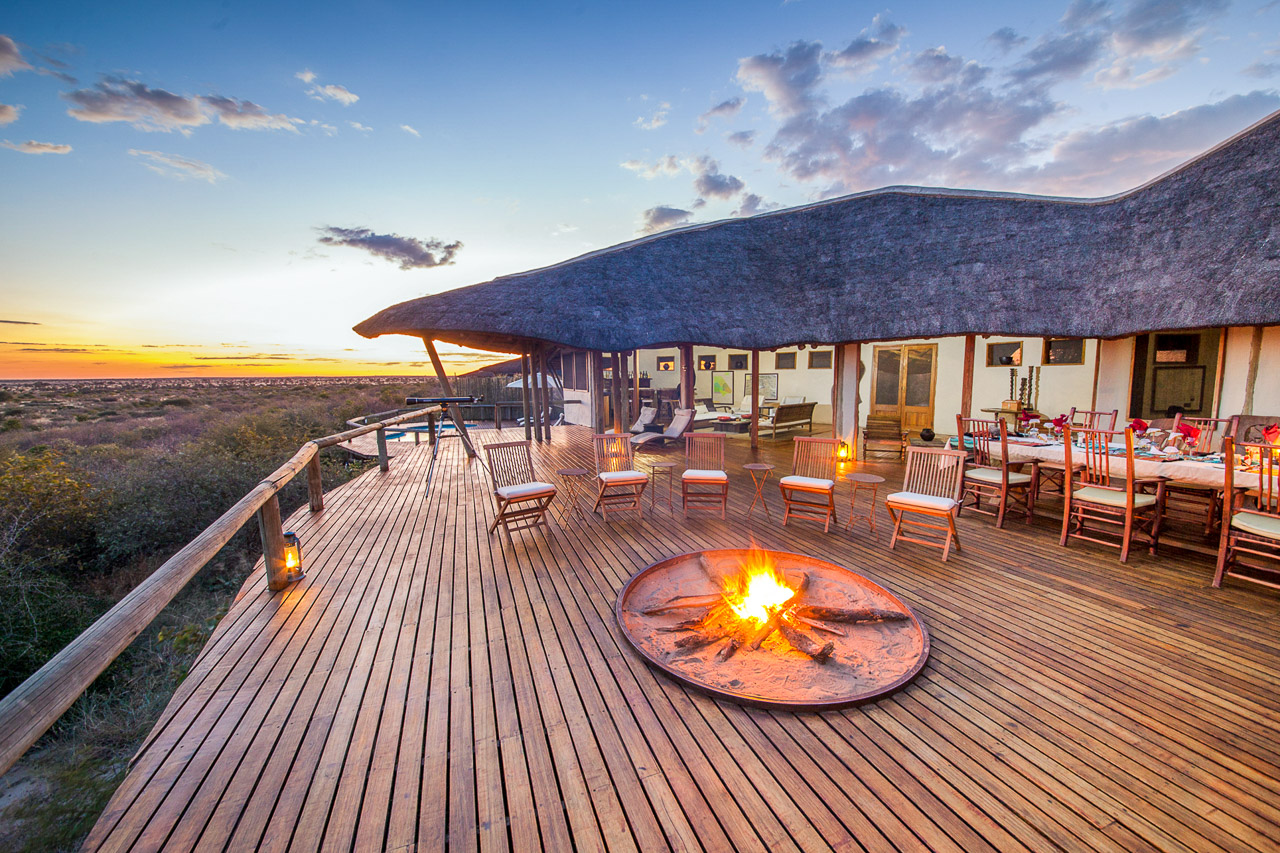
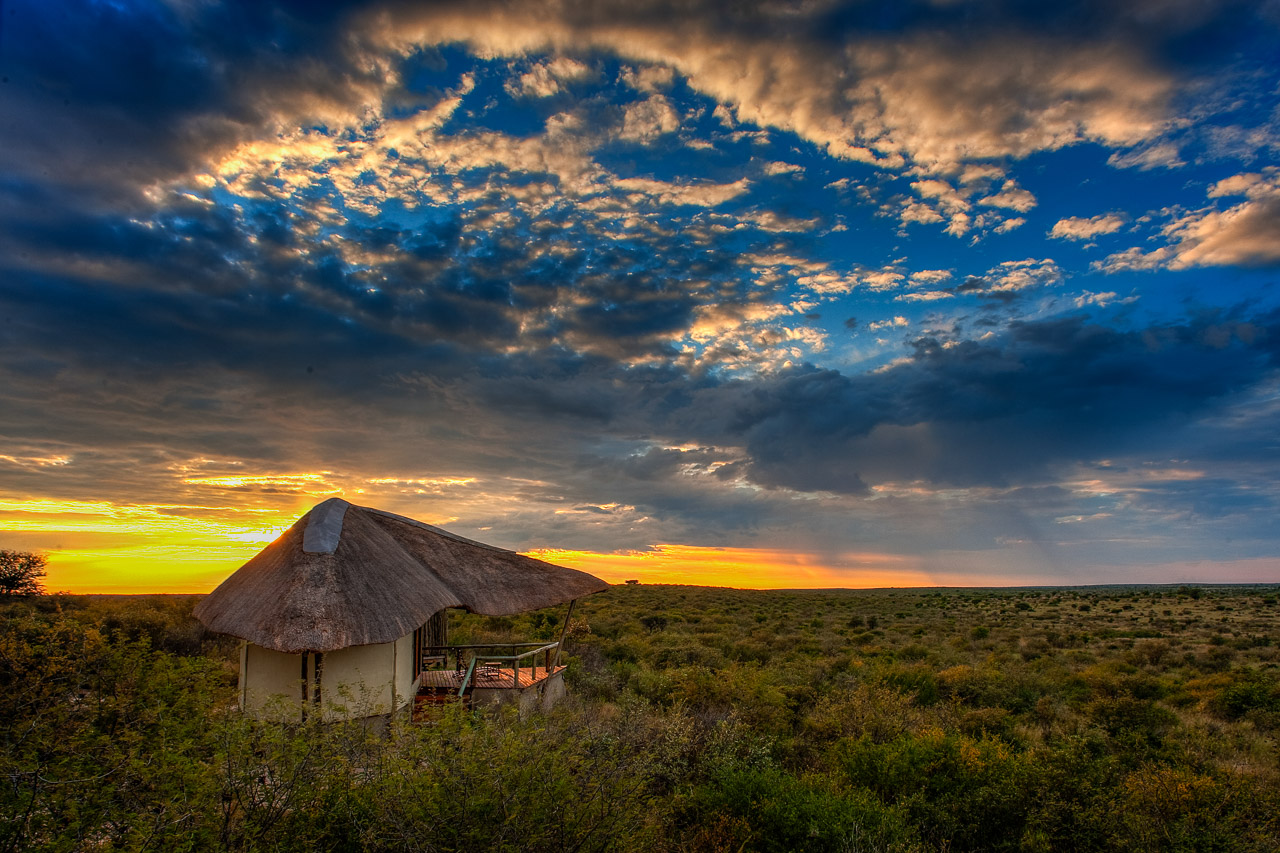
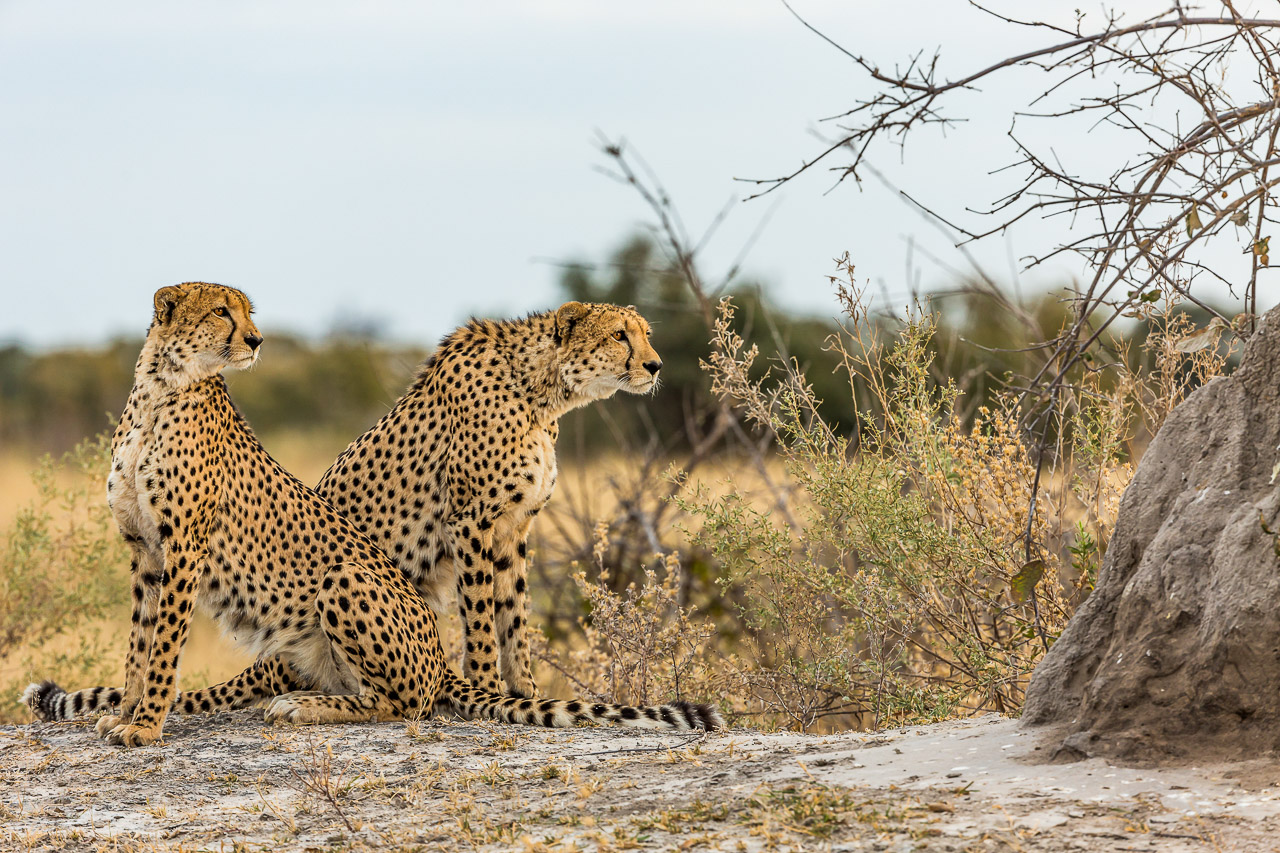
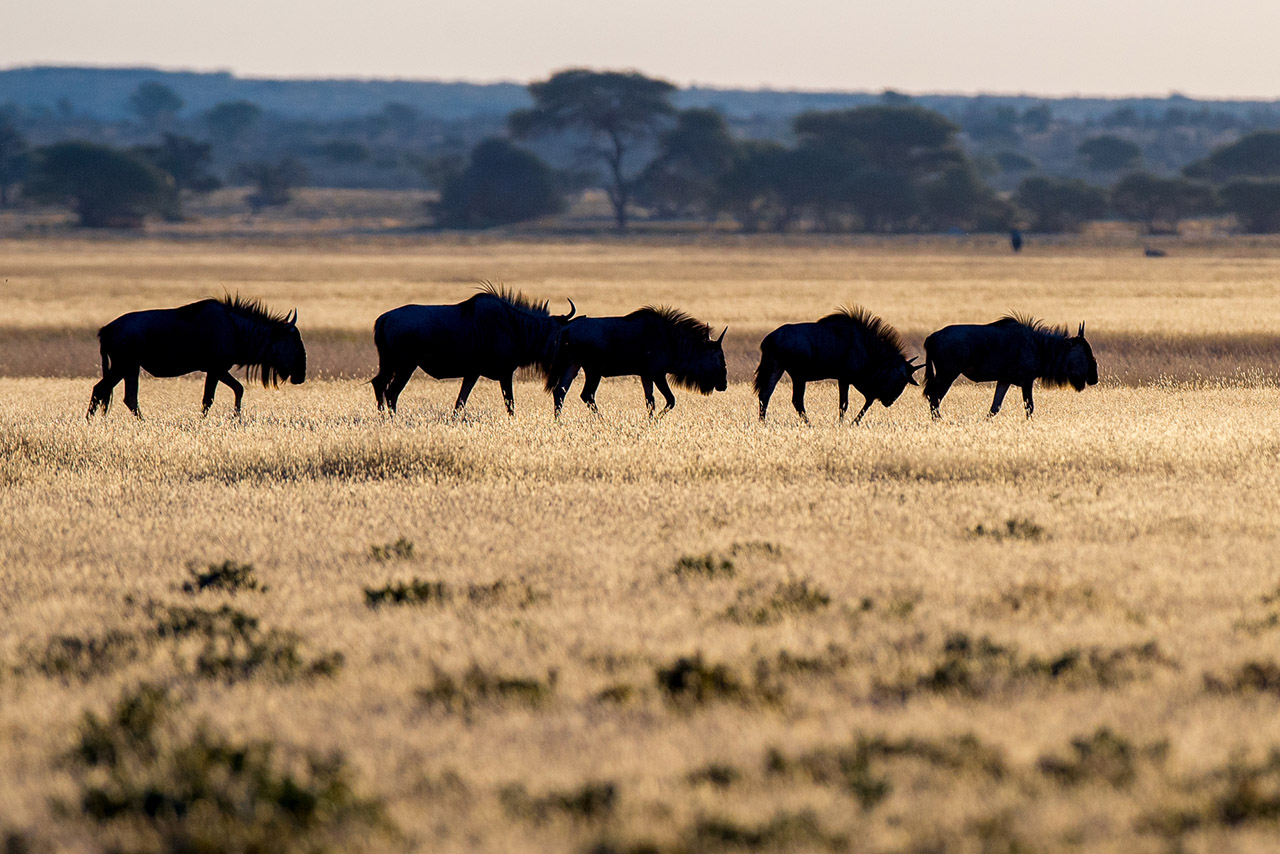
Accommodation
Tau Pan Camp is situated in one of the most beautiful places in the Kalahari and has a magnificent view over the plains of the Tau Pan. The nine rooms (one of which is a family room) are elevated on platforms and have a thatched roof that extends far towards the front and protects the terrace from rain and sunshine. All rooms have en-suite bathrooms with double lavabo, WC and an additional outdoor shower.
At the central main building there is a small library, a souvenir shop, a restaurant with a large outdoor terrace and, in a separate building, a plunge pool with sun loungers. At the eastern end of the camp, a sleep-out platform offers the guest the opportunity to spend the night under the stars. For stays of 3 nights or more, a sleep-out can be pre-booked free of charge. The nights in the Kalahari are often incredibly clear with minimal light pollution.
Tau Pan Camp is situated on a ridge on the edge of Tau Pan. The Tau Pan is a beautiful open grass plain in the middle of the Kalahari and a magnet for many animals, especially lions.
The flight from Maun to Tau Pan Airstrip takes about one hour. The drive from the airstrip to the camp takes about 15 minutes.
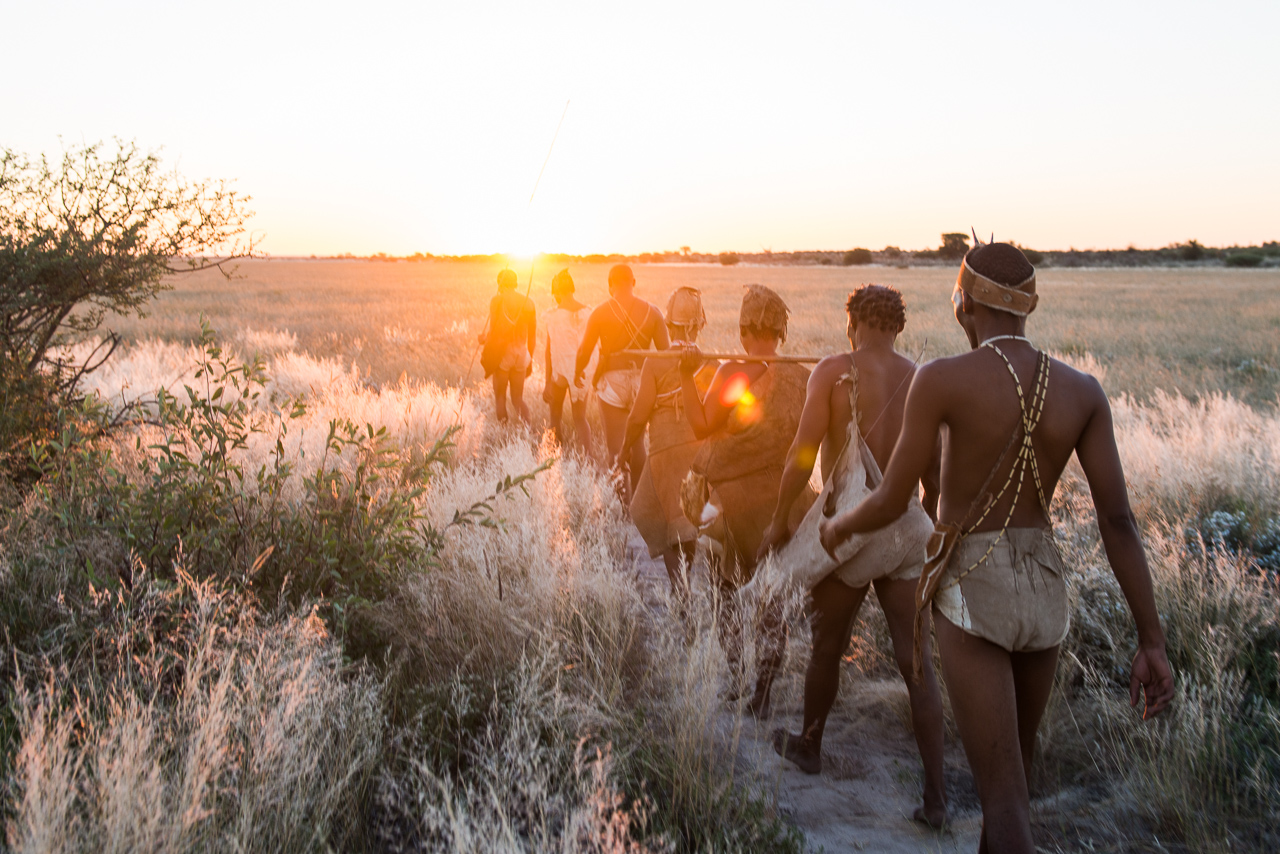
Covering more than one million km², the Kalahari Desert stretches from the South Africa/Namibia border (Kgalagadi Transfrontier Park) to Zambia/Angola, and encompasses the Okavango Delta. Unlike the Kgalagadi Sector, where red sand dunes dominate the landscape, the central part of the Kalahari comprises shrubs emerging from light coloured sand.
This seemingly endless expanse is home to several open ‘valleys’ and beautiful grassy plains. The most famous of these valleys is Deception Valley, and the best-known waterholes include Piper Pan, Tau Pan, Leopard Pan and Sunday Pan. Deception Valley and the pans attract a dense population of game during the wet season, mainly oryx and springbok, neither of which are to be found in the Okavango Delta. The greatest attraction here, however, is the black-maned Kalahari lion, which has learned to survive in this arid environment, and is able to go with out water for long periods of time. With a bit of luck, visitors may also spot cheetah, which has become much less common in other areas.
The best time to visit the Kalahari is from December to April. Every now and then a storm breaks over the Kalahari at the end of a scorching day, bringing with it long-awaited moisture to an otherwise parched region. Afterwards, the air is clean, the view clear, the stars in the night sky seem close enough to touch and the heavens hover like an immense blanket that gently covers everything.
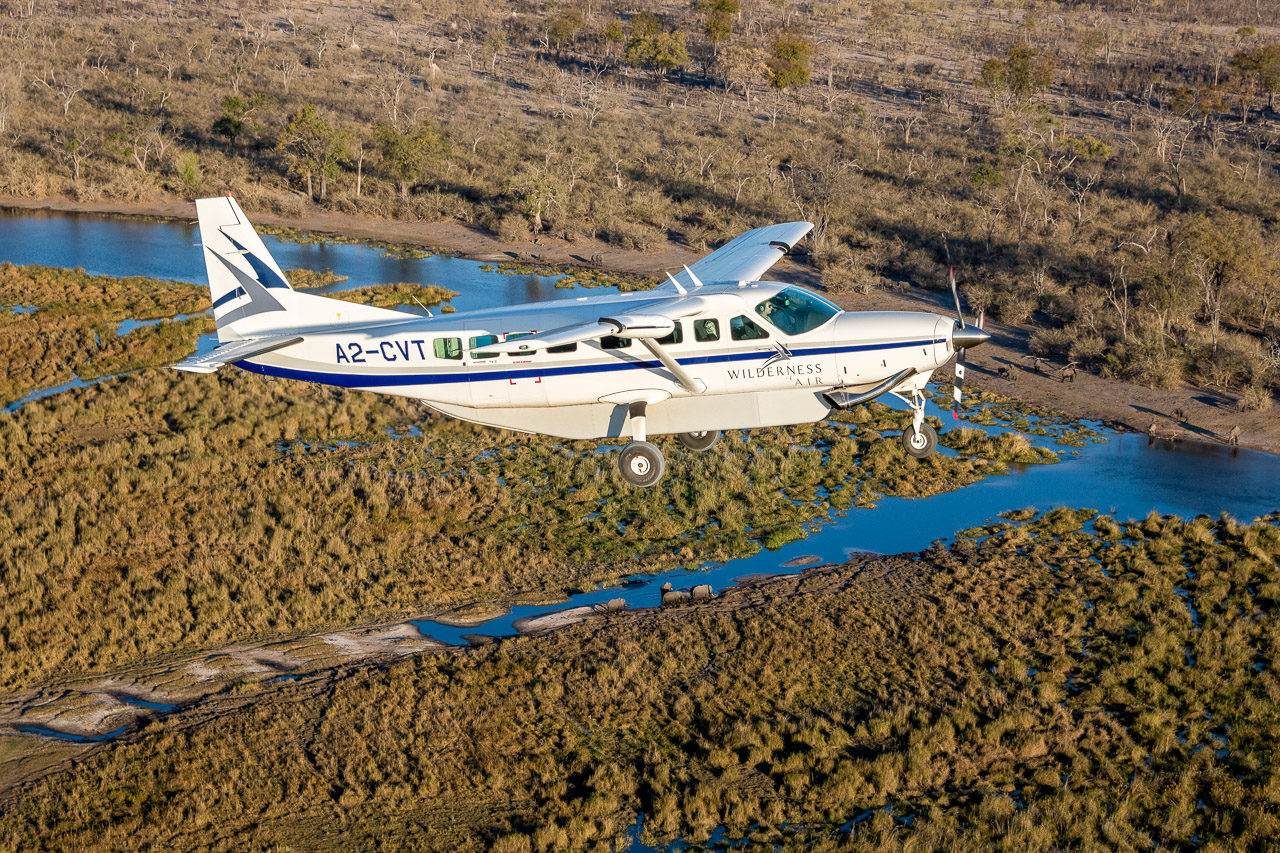

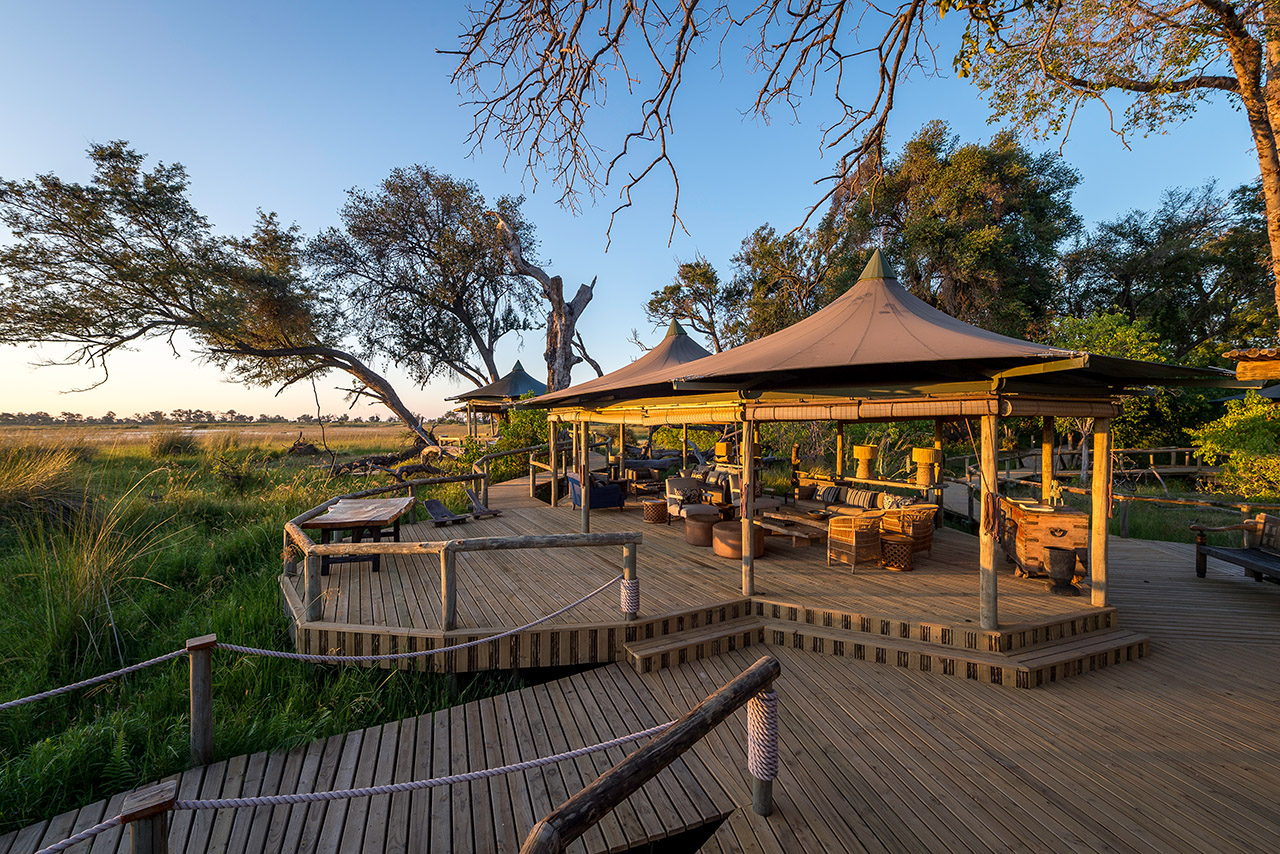
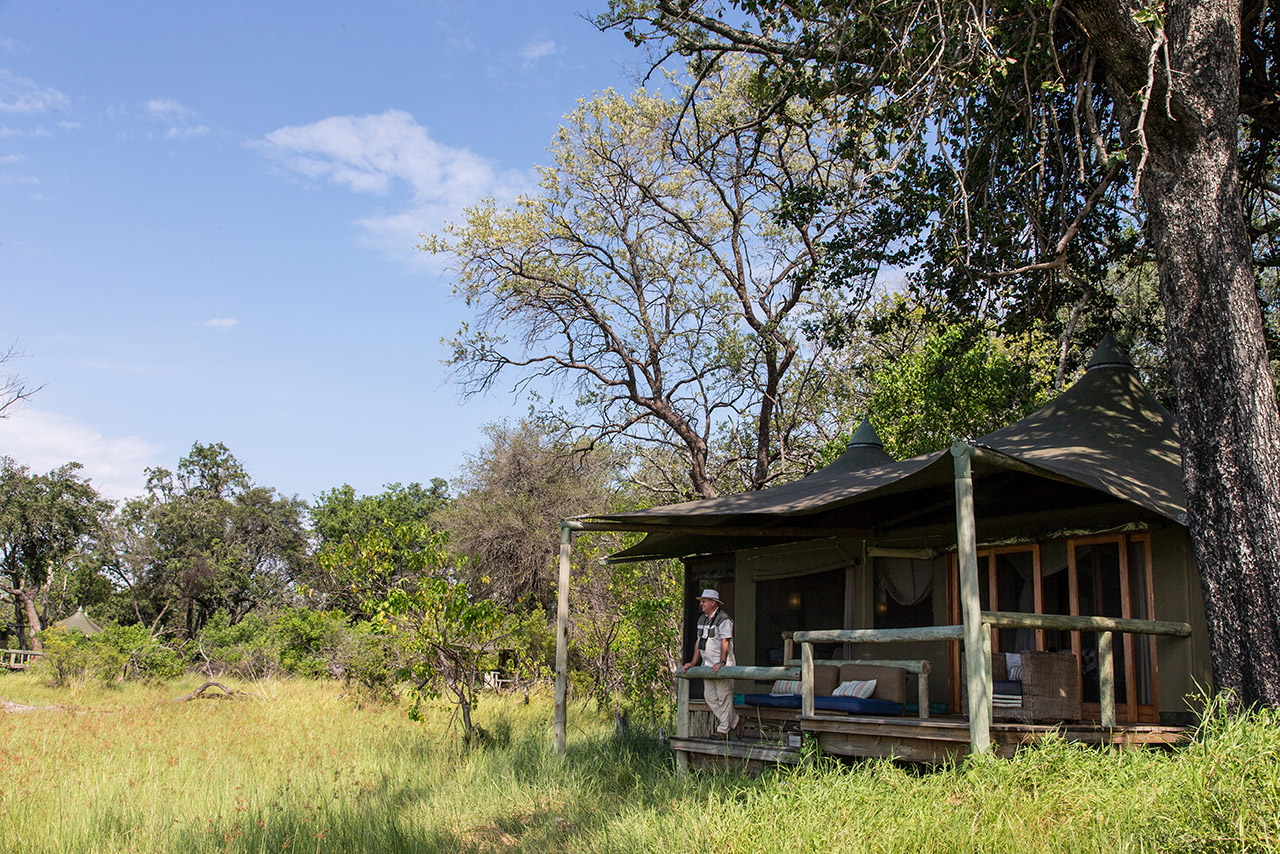
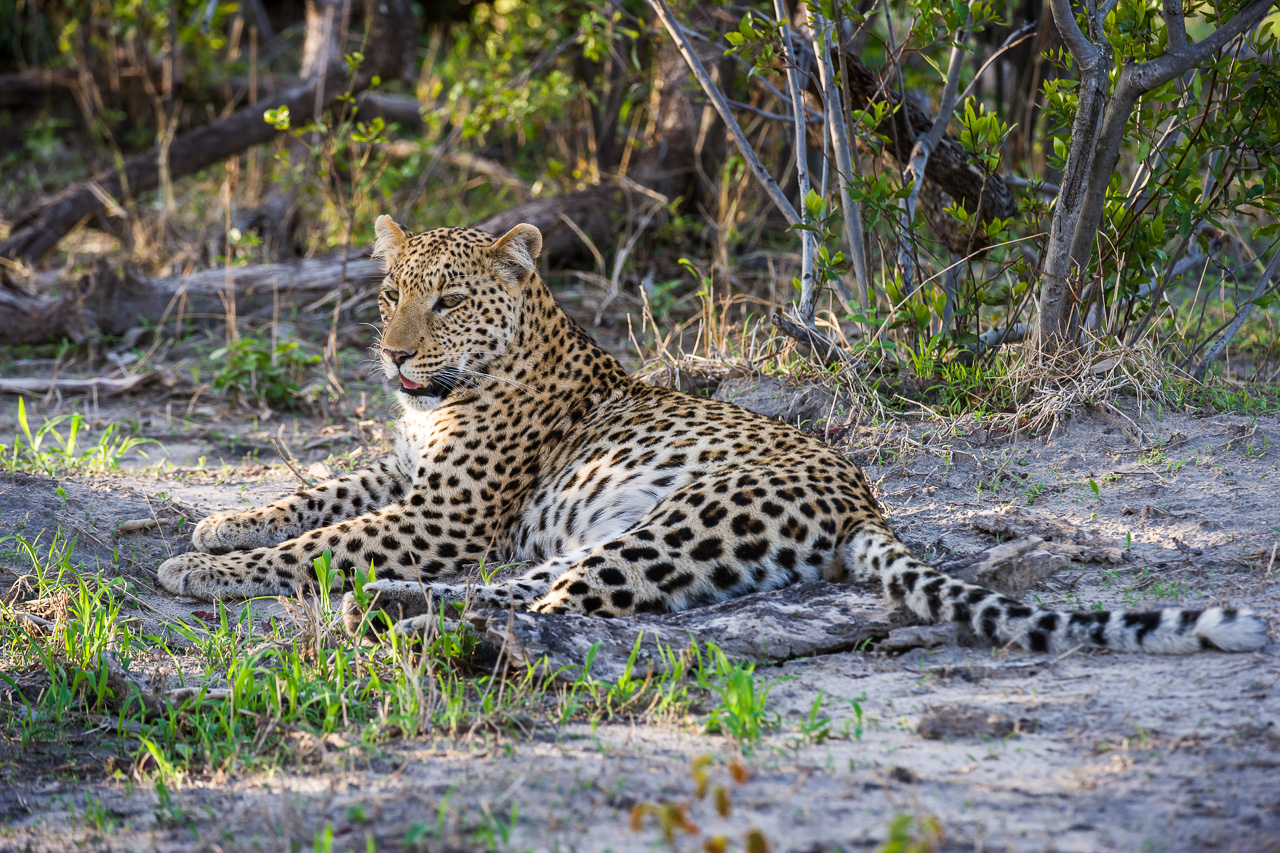
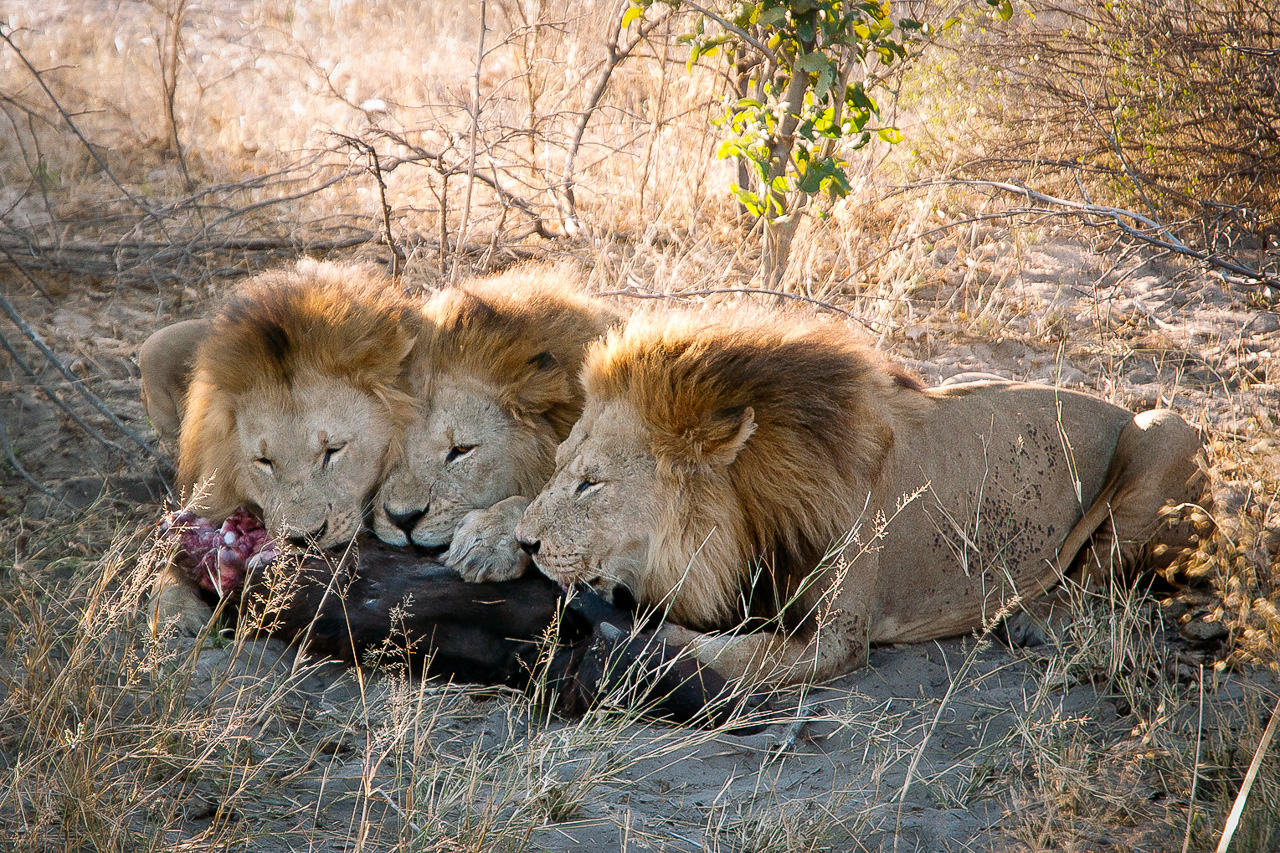
Accommodation The charming Little Vumbura Camp has six large and lovingly furnished rooms, each with en-suite facilities, veranda with lounge sofa and, of course, spectacular panoramic views. A beautiful pool is located close to the main building, which also houses a large outdoor deck with fire pit, an open dining area with bar, a very comfortable lounge and a small library. The whole is finished in the style of a typical ‘small but nice' bush camp.
Little Vumbura is the little sister of the premier Vumbura Plains Camp. It is situated on a picturesque green island and is surrounded by broad rivers and reed-covered plains in the north of the Okavango Delta. It's out of the jeep and into a motorboat for the last 500m to the camp, as you chug along greeting the hippos.
Little Vumbura Camp is only accessible by light aircraft. The private airstrip is located approximately 45 minutes from the camp. Flight time to Maun in a Cessna Caravan is 35 minutes, and 1 hour 15 minutes to Kasane.
Little Vumbura Camp is part of the private Kwedi Concession (900 km²). Vumbura Plains Camp also belongs to this concession.
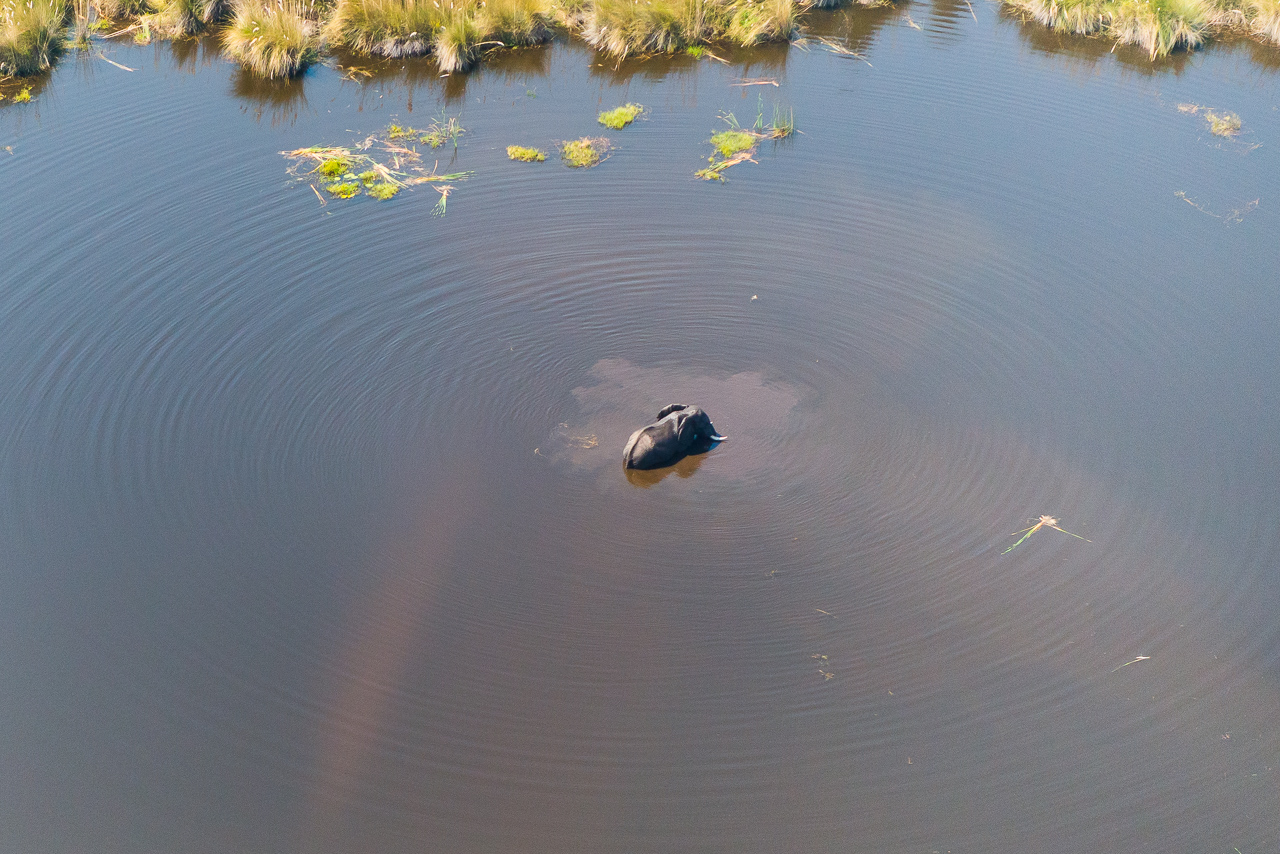
Guests can look forward to first-class service at exclusive and stunning lodges set amid pristine wilderness. The Okavango Delta is an inland delta in the north of Botswana, which can be accessed via Maun or Kasane. Some areas on the edge of the delta are accessible by vehicle, but the vast majority of lodges here are located deep in the delta, which means they are only accessible by air and therefore highly exclusive.
The Okavango Delta plays host to a fascinating cycle of rain, flood, drought, heat and cold. These processes determine the behaviour of the animals and their migration paths. The onset of rain in November / December leads to the appearance of spectacular green meadows as dormant flora springs back to life, trees sprout new leaves and colours become vivid and saturated. The vast majority of animals give birth to their young at the beginning of the wet season, which means the whole area is teeming with baby elephant, impala and kudu – big cat often gives birth to its young at this time too.
The sporadic rains continue until the end of March. Temperatures slowly drop and a feeling of spring sets in around April. The nights become cooler and dew settles on the grass, causing it to sparkling in the sun’s first rays of light when guests can be found pulling up their hoods in preparation for the early morning game drives. The floodwaters reach the delta in April, sometimes earlier, and, covering immense areas, expand outward like a living, breathing organism. The floodwater is basically rainwater from the mountains of Angola, which slowly accumulates in the Okavango River over a period of several months. It squeezes through the panhandle, which is where the Okavango Delta fans out, and then floods the entire region. The well-equipped game drive vehicles struggle through metre-deep water from one island to the next, leaving passengers awestruck and wondering how the journey is at all possible.
The coolest temperatures are measured in June / July, when night time lows can drop as far as 5°C, and welcome hot water bottles are duly distributed! Well-wrapped guests come prepared for the early morning game drives with hats, gloves and warm jackets. Daytime temperatures are pleasant and the skies are clear with bright sunshine – every day! The sun’s heat dominates once again as September approaches, the alluvial areas begin to dry out and the short, dry grass offers a clear and welcome view of the entire spectrum of wildlife here. Temperatures climb to their maximum in October as the whole parched region once again anticipates the coming rains. When huge clouds begin to gather on the horizon, you know it’s only a matter of time until the whole cycle begins again.
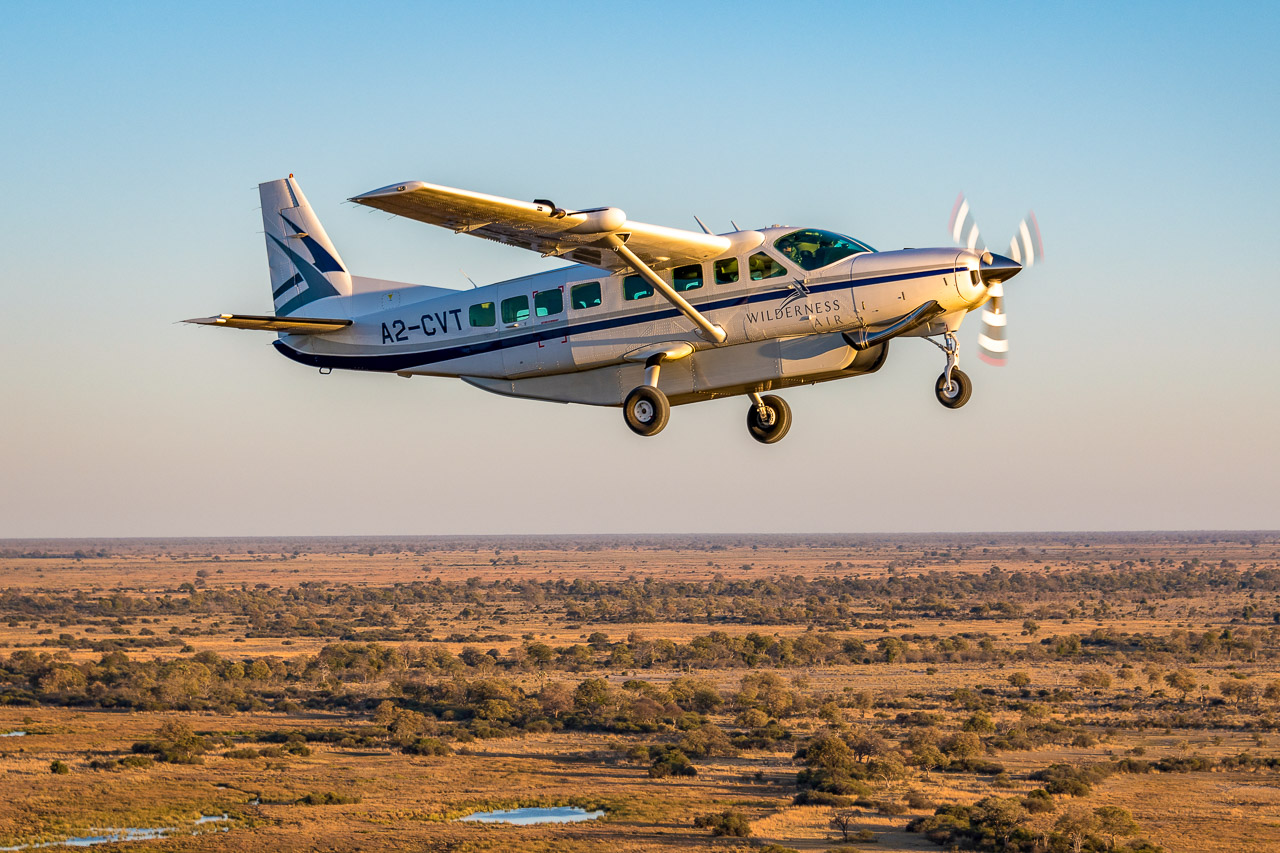


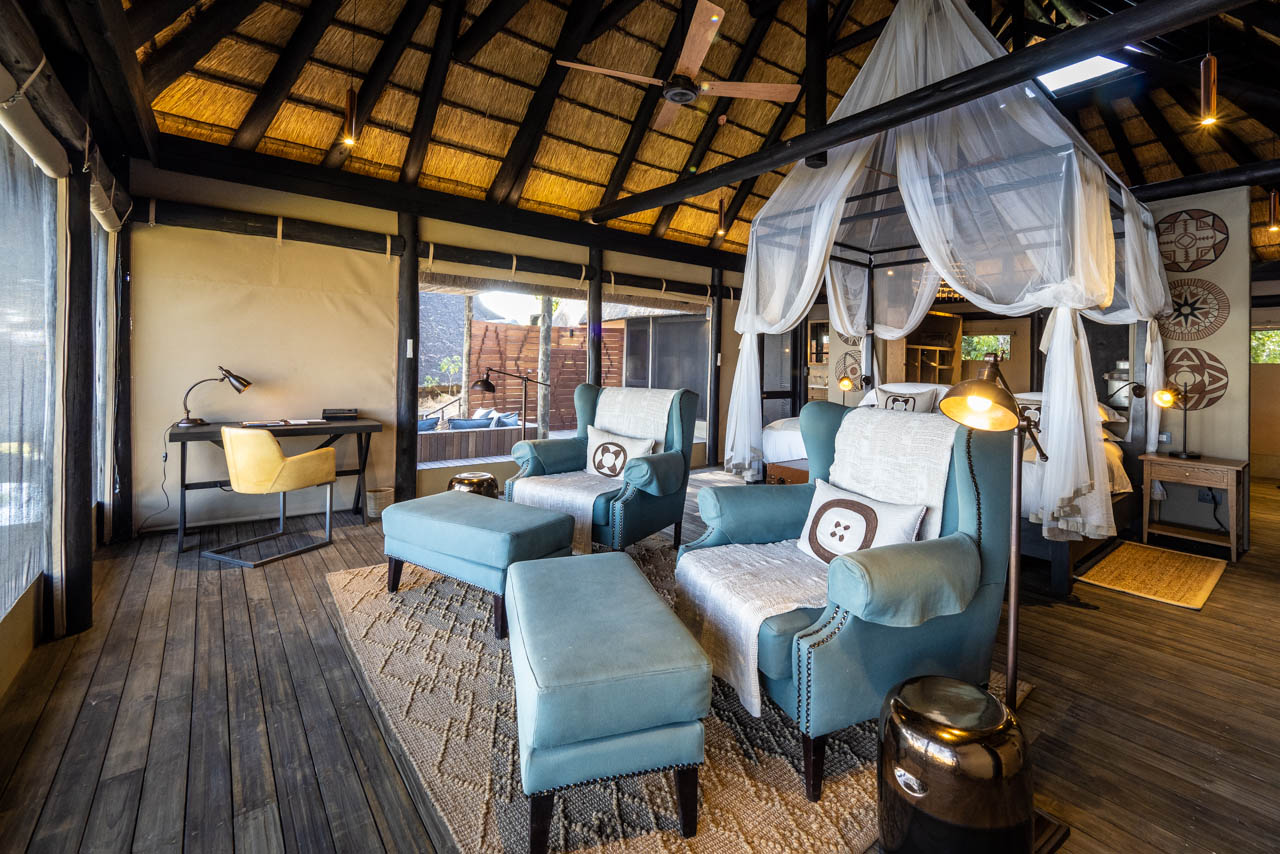
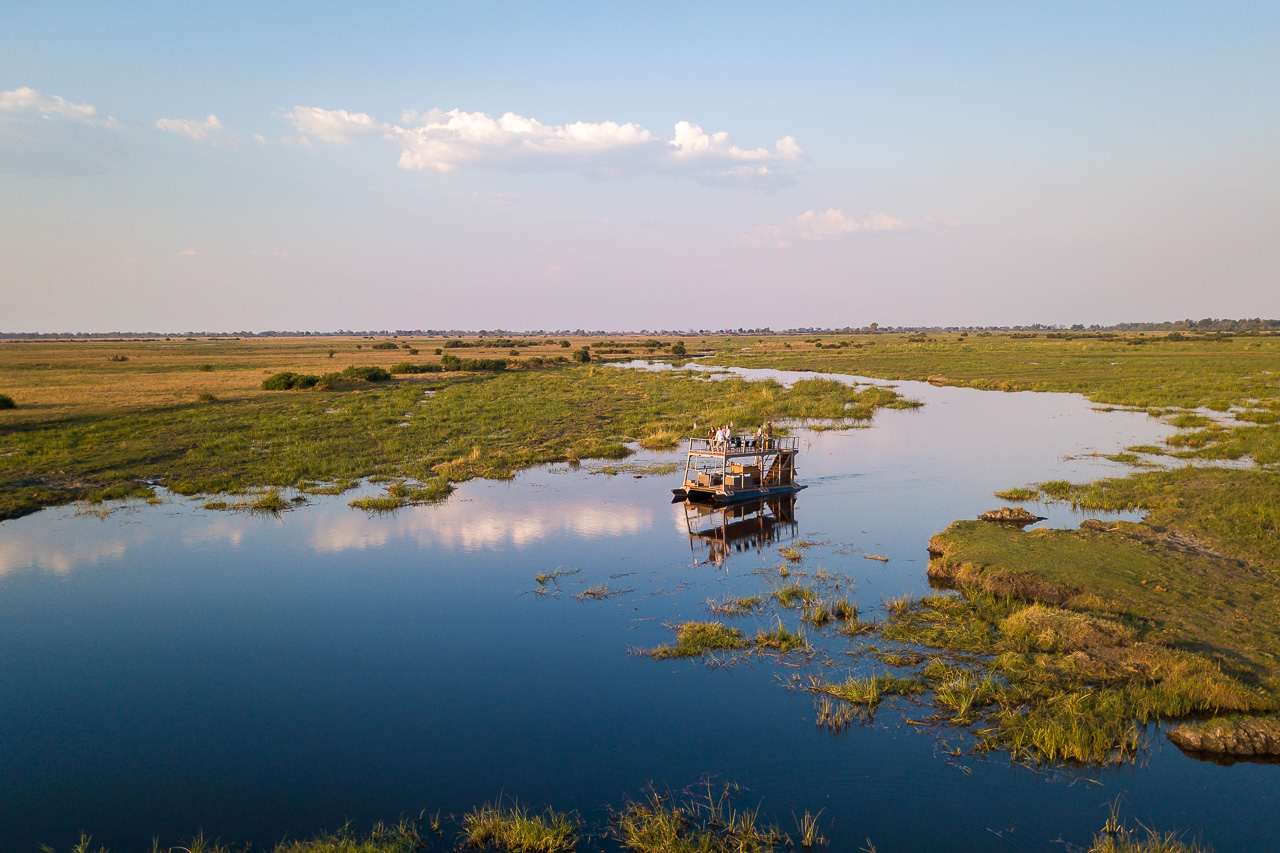
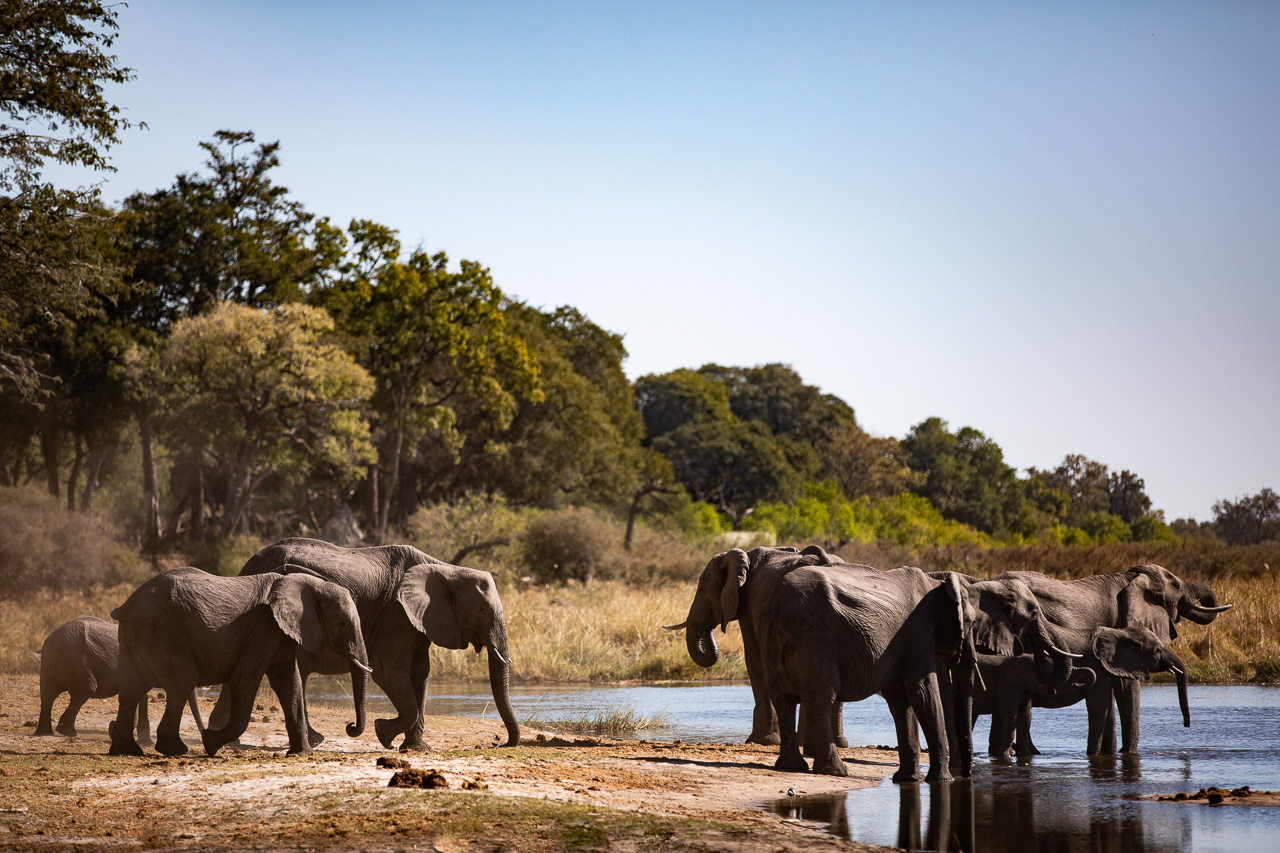
Accommodation
Kings Pool Camp's eight spacious rooms are situated on a branch of the Linyanti River, the so-called Kings Pool Lagoon. Each room has a large sleeping area with en-suite bathroom, indoor and outdoor shower and an outdoor lounge where you can relax, read and enjoy the view of the lagoon. One of the rooms is suitable for families and has two en-suite bedrooms and a plunge pool.
The main building has been kept in dark colours - an elegant, timeless and really very tasteful design that skilfully captures the camp's royal history. It features a lounge with a fireplace, the bar, the restaurant with an outdoor area and a sunken lounge, as well as a pool.
Elephant and hippo can often be seen strolling past and grazing on the plains to the front of the camp. Guests of Kings Pool are accompanied by a chorus of grunting hippo as the lagoon in front of the camp is full of them.
Kings Pool Camp is only accessible by light aircraft. The camp is situated approx. 60 minutes drive from the airstrip. Flight time to Maun in a Cessna Caravan is 50 minutes, and 45 minutes to Kasane.
Kings Pool Camp is part of the private Linyanti Concession (1,200 km²). Duma Tau Camp and Savuti Camp share the same concession.
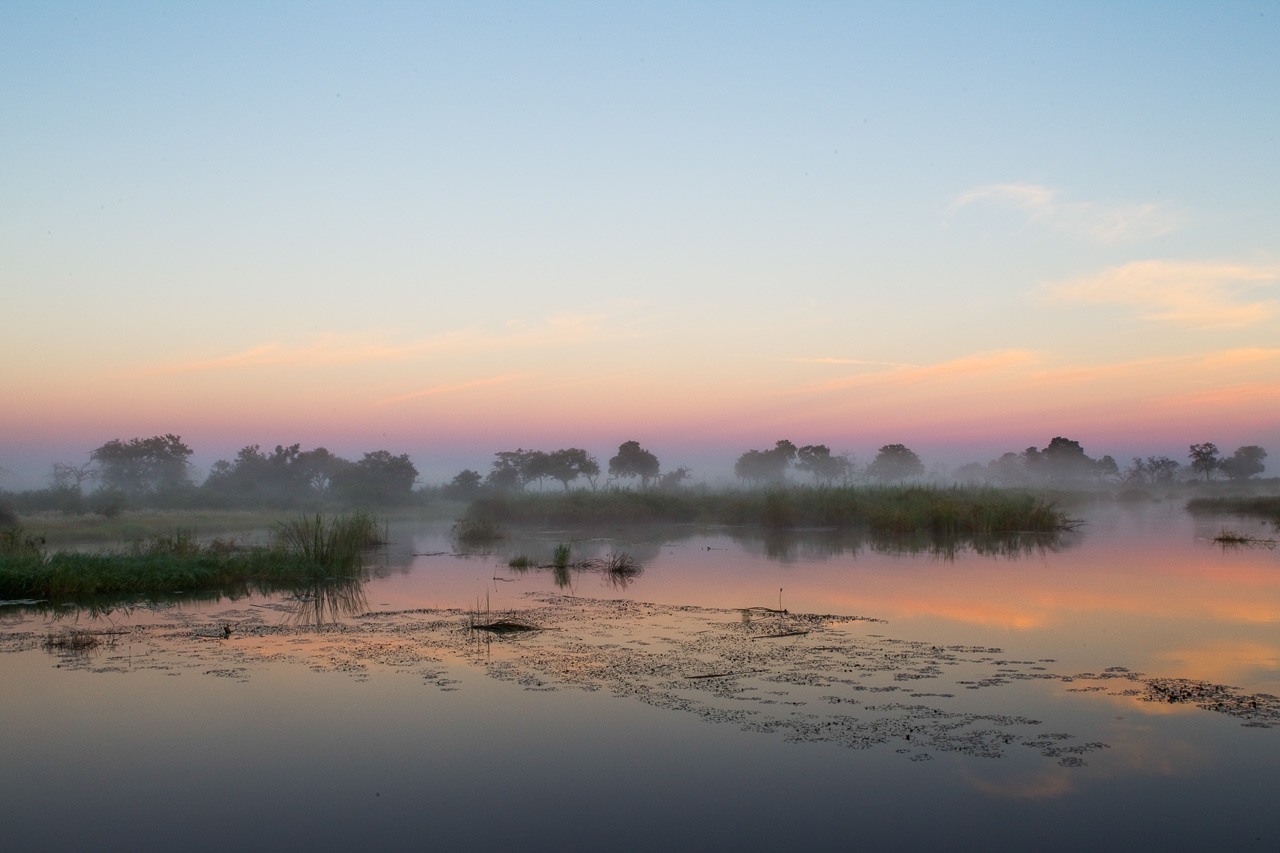
As in the Okavango Delta, we only book stunning, highly exclusive lodges situated in unspoiled nature that are often only accessible by air. The Linyanti region can be divided into four distinct areas, namely the Kwando Concession of Kwando Safaris, the Selinda Plains of Great Plains, the actual Linyanti Block of Wilderness and the Chobe Enclave, where African Bush Camps operate some of their camps.
The Linyanti region allows you to see clearly the influence of tectonic activity in the area. It is believed that the Okavango, Kwando and Zambezi rivers originally flooded much of Botswana, including the Makgadikgadi Pans. Today, the Kwando River flows through the Caprivi Strip in Namibia and heads south towards Botswana. The water hits a slight elevation, which dams the river and forms the Linyanti Wetlands. Here it takes a sharp turn to the east before continuing its journey as the Linyanti River. It then becomes the Chobe River at Kasane before finally flowing into the great Zambezi. The Linyanti Wetlands connect to the Okavango Delta via the Selinda Spillway, a kind of overflow system of the Okavango Delta. Water has been flowing here again during the winter months for several years now, making it the ideal location for canoeing safaris. The Okavango Delta’s increased water level has also returned water to the Zibadianja Lagoon – its outlet, the Savuti Canal, now has sometimes water running along its entire length, feeding the Savuti Marsh!
Although the area has seen dramatic changes in recent years, the Linyanti River still attracts a large number of elephant and buffalo from the Chobe Forests during the dry season, and is therefore still the perfect place to experience memorable game drives.
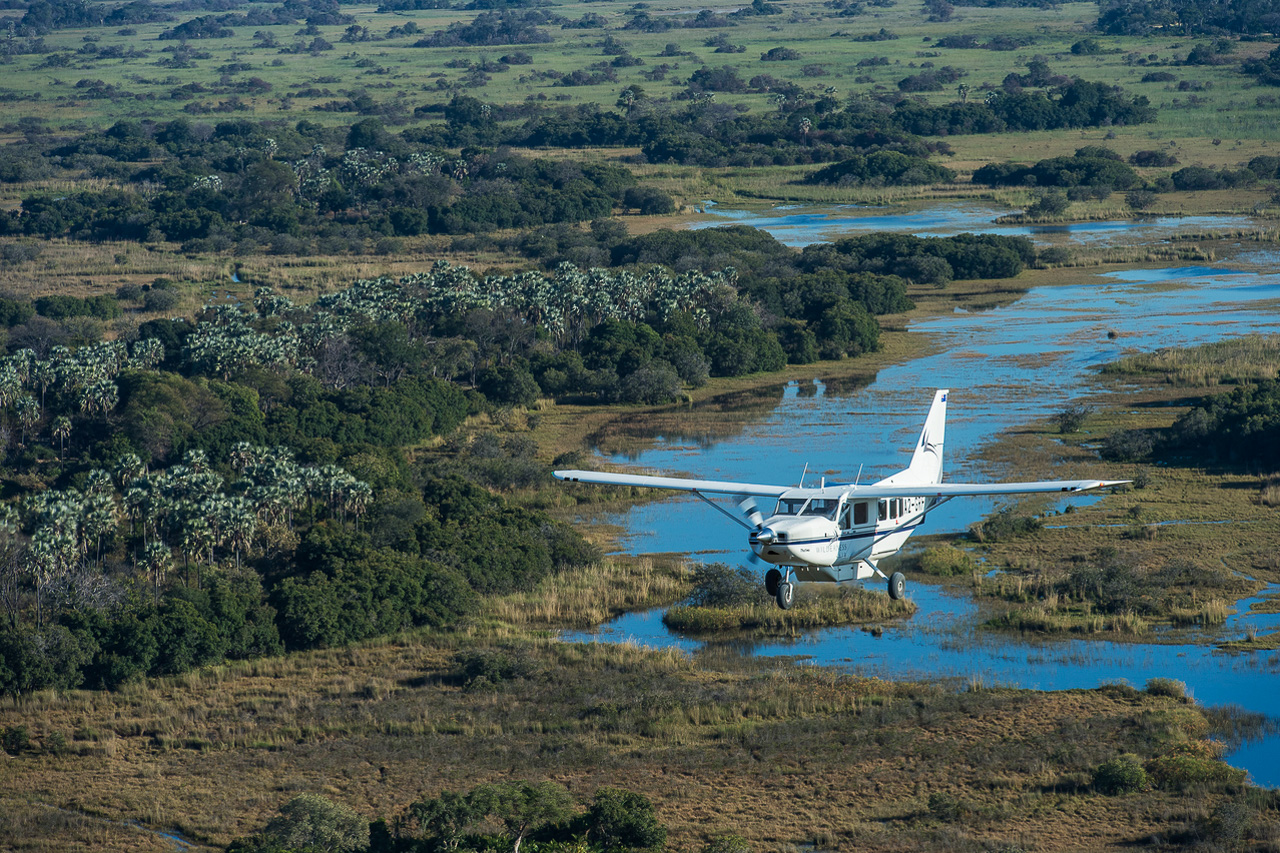

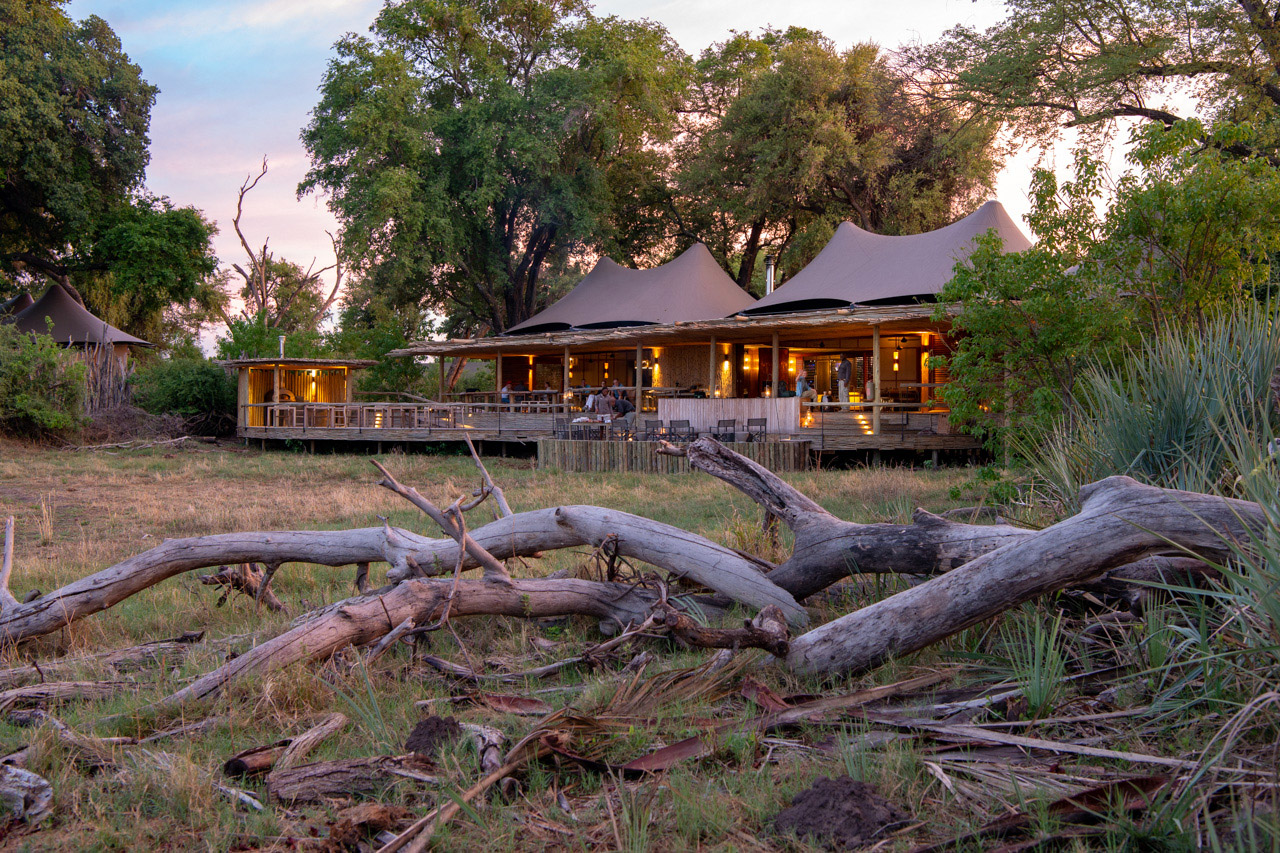
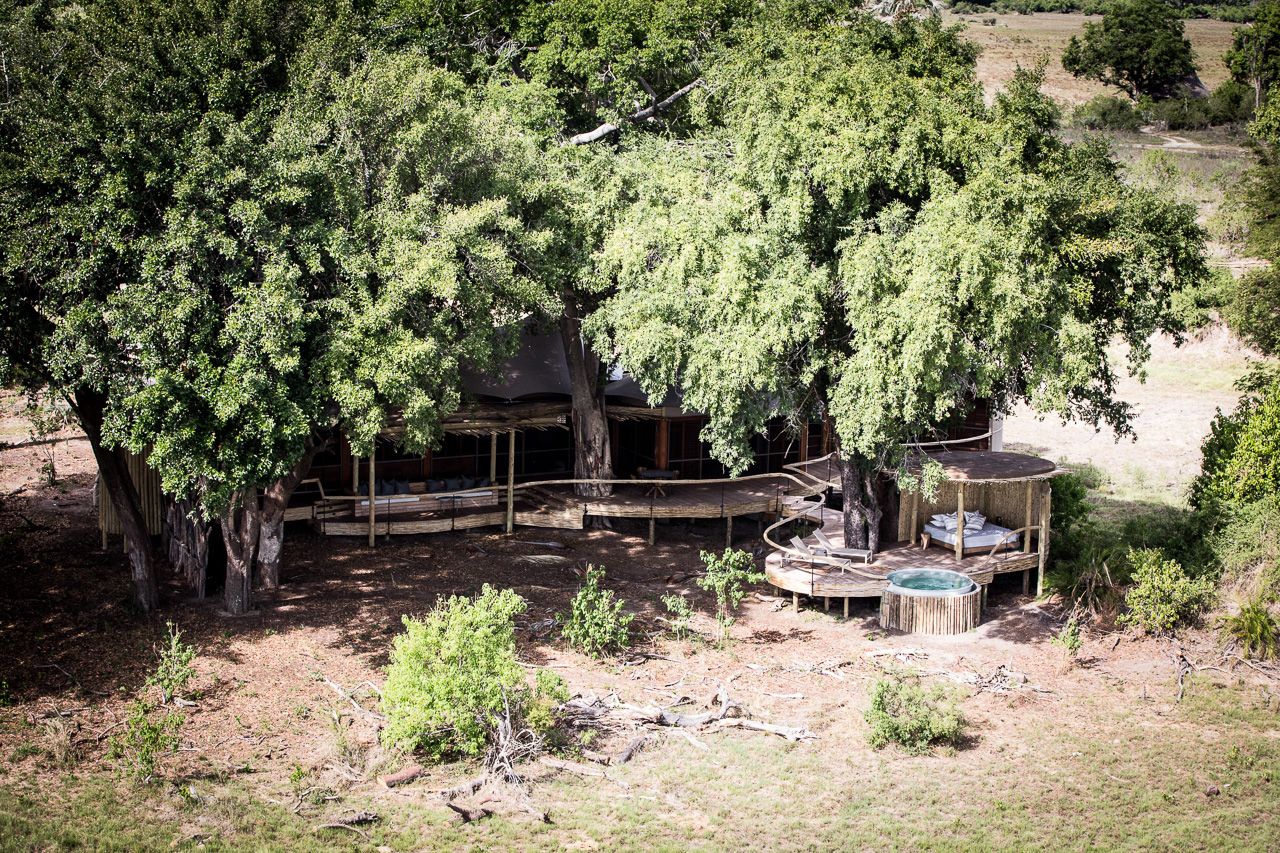
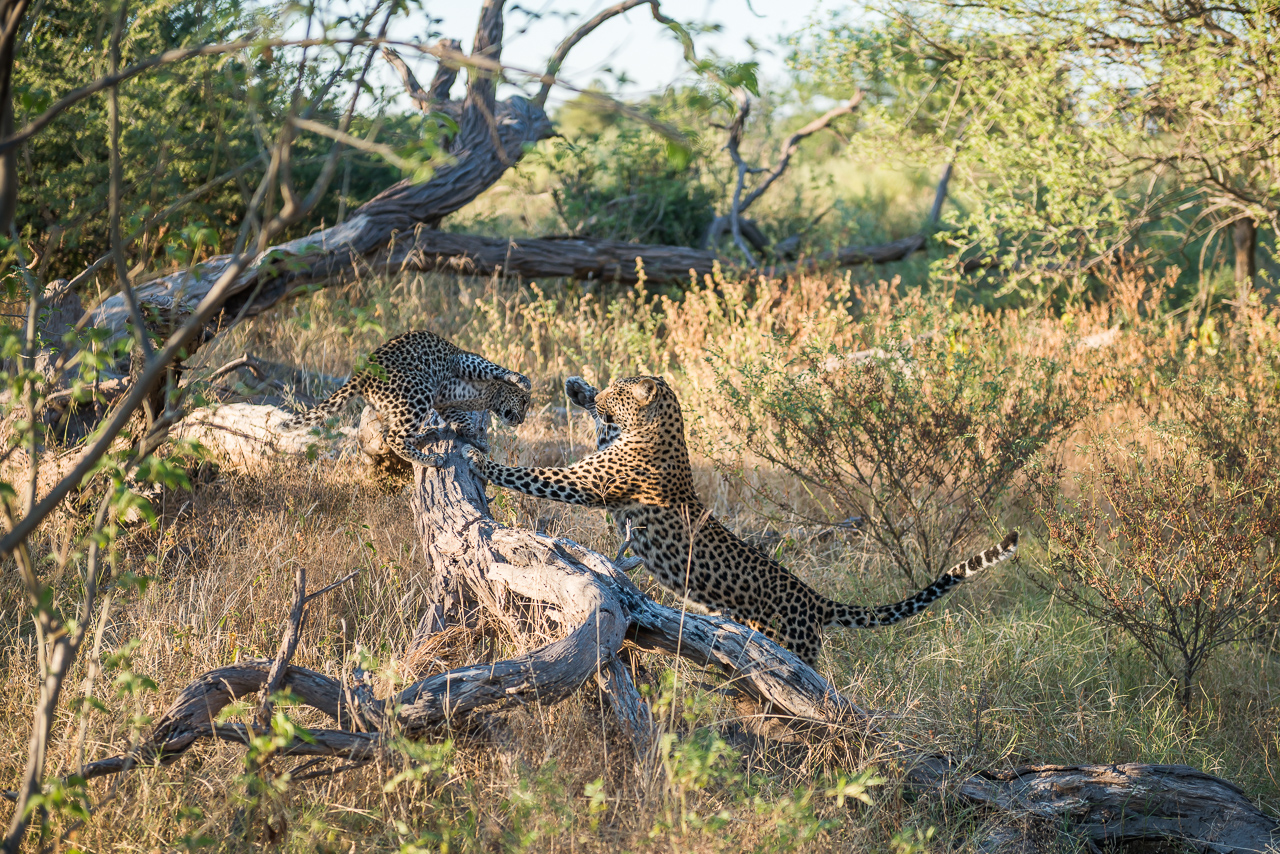
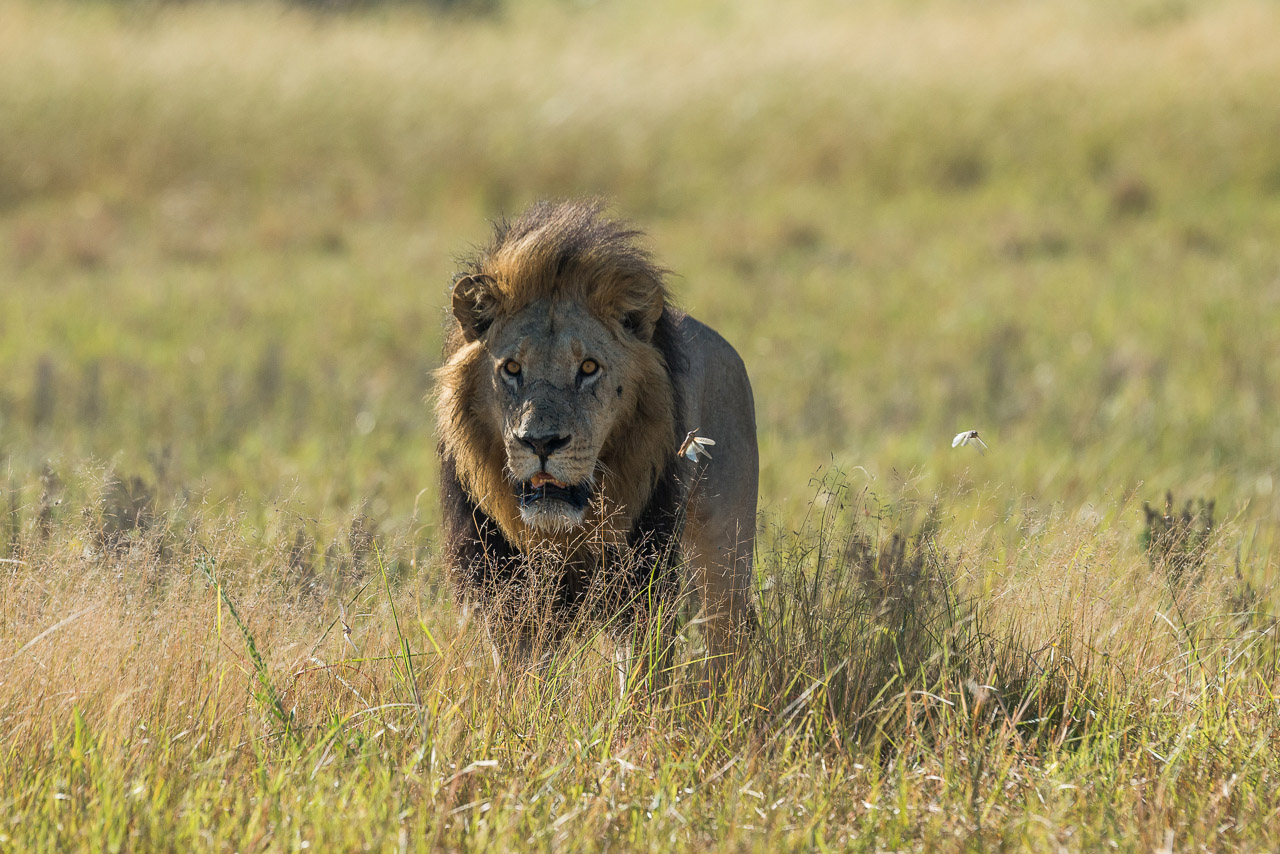
Accommodation
The rooms at Mombo (7 x twin + 1 x family room with two en-suite bedrooms) and Little Mombo (4 x twin) are generously equipped, each with a comfortable en-suite, living and sleeping area, indoor and outdoor shower, private bar, sala (outdoor lounger) and large veranda.
All rooms and main areas have large decks from where a huge variety of wildlife can be viewed at any time of day. The plain to the front of the camp fills with water during the floods, attracting a large number of water-loving red lechwe and buffalo.
Mombo and Little Mombo are linked by a long wooden walkway (approx. 5 minutes apart) with a swimming pool, gym and spa room as connecting elements. Both Mombo and Little Mombo have a stylish lounge, bar and dining area. A beautiful curio shop completes Mombo Camp's main building.
Mombo Camp is the flagship of Wilderness and unbeatable in its combination of luxury and pure wildlife action.
Chief's Island is the largest landmass in the Okavango Delta, and home to an incredible variety of wildlife. Both camps conduct game drives in the same area.
Mombo Camp is only accessible by light aircraft. The private airstrip is located just 15 minutes from the camp. Flight time to Maun in a Cessna Caravan is 30 minutes, and 1 hour 20 minutes to Kasane.
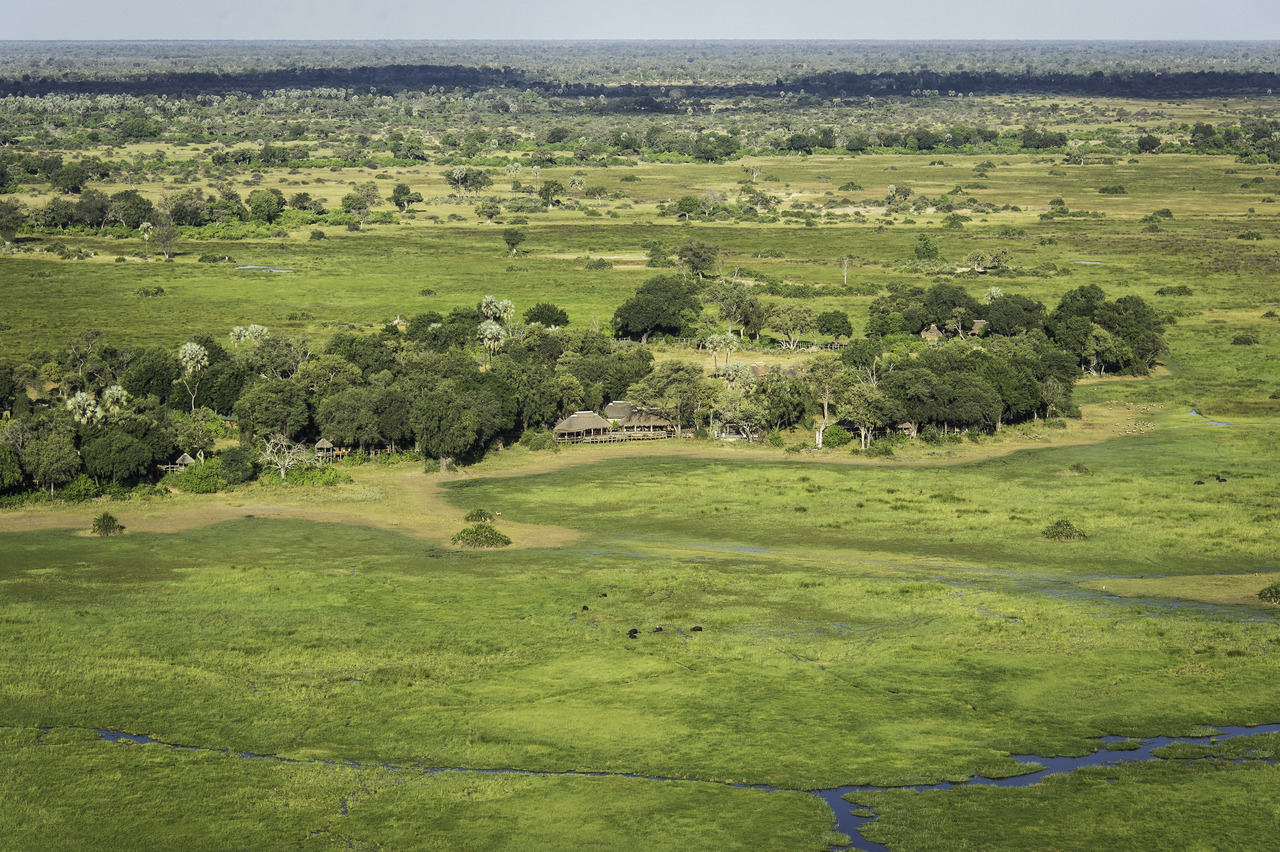
The Moremi was proclaimed a reserve in 1963 by the widow of Chief Moremi III and expanded in several stages thereafter. Today it covers around 30% of the entire Okavango Delta and adheres to a very strict protection policy.
Simply put, the Moremi Game Reserve comprises a lot of water and two large dry plains: the first is Chief's Island (home to the renowned Mombo Camp), which extends deep into the Okavango Delta. The second is known as the Mopane Tongue, the corners of which are marked in the Khwai region by the North Gate, South Gate, Mboma Island and Xakanaxa. Unlike Chief’s Island, whose camps are only accessible by air, the Mopane Tongue is accessible by vehicle.
Similar considerations apply to the Mopane Tongue as to the Chobe-Savuti region: overlanders and providers of mobile safaris travel from Maun to this area and camp at the public campsites or choose the more luxurious option of a private pitch. For this reason, when embarking on a flight safari, we recommend you choose the more expensive but private camps on Chief's Island for the ultimate safari experience.
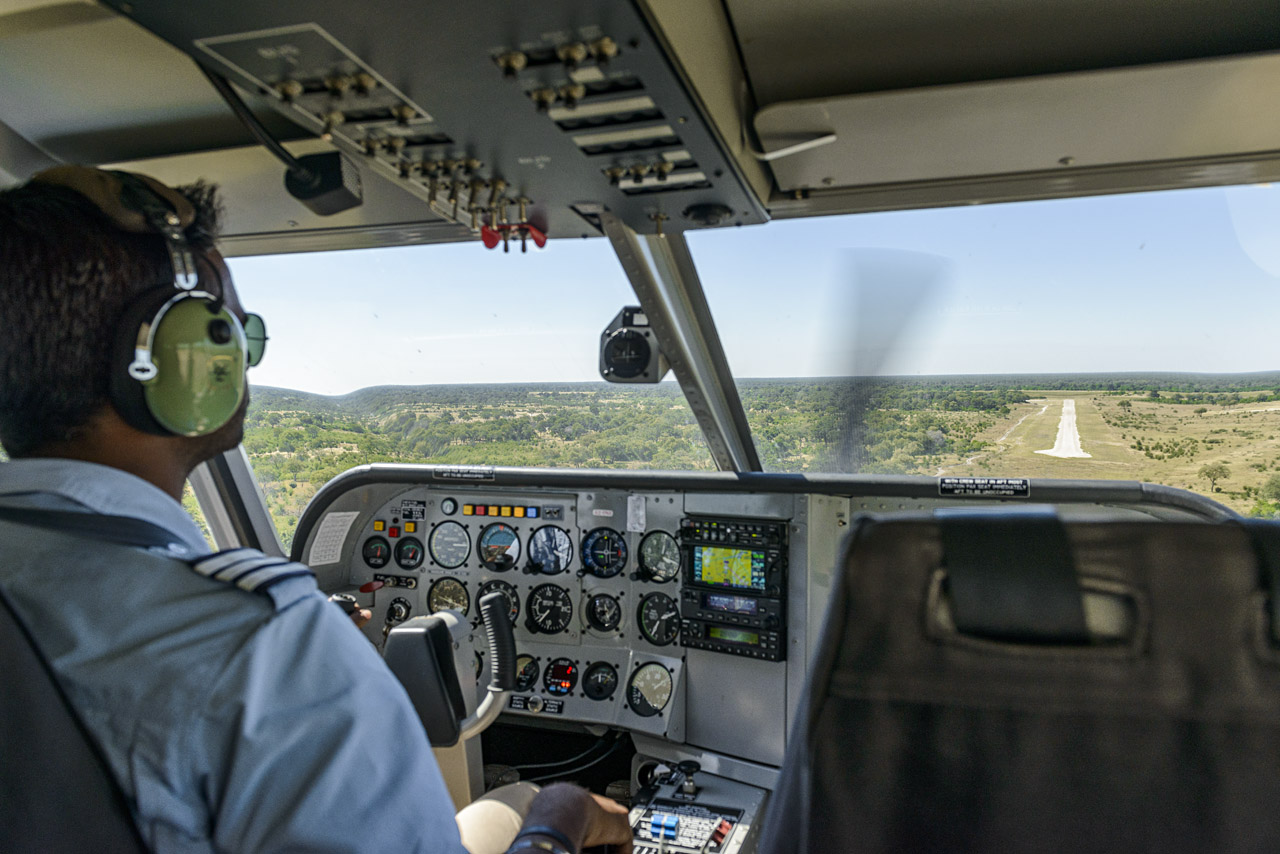
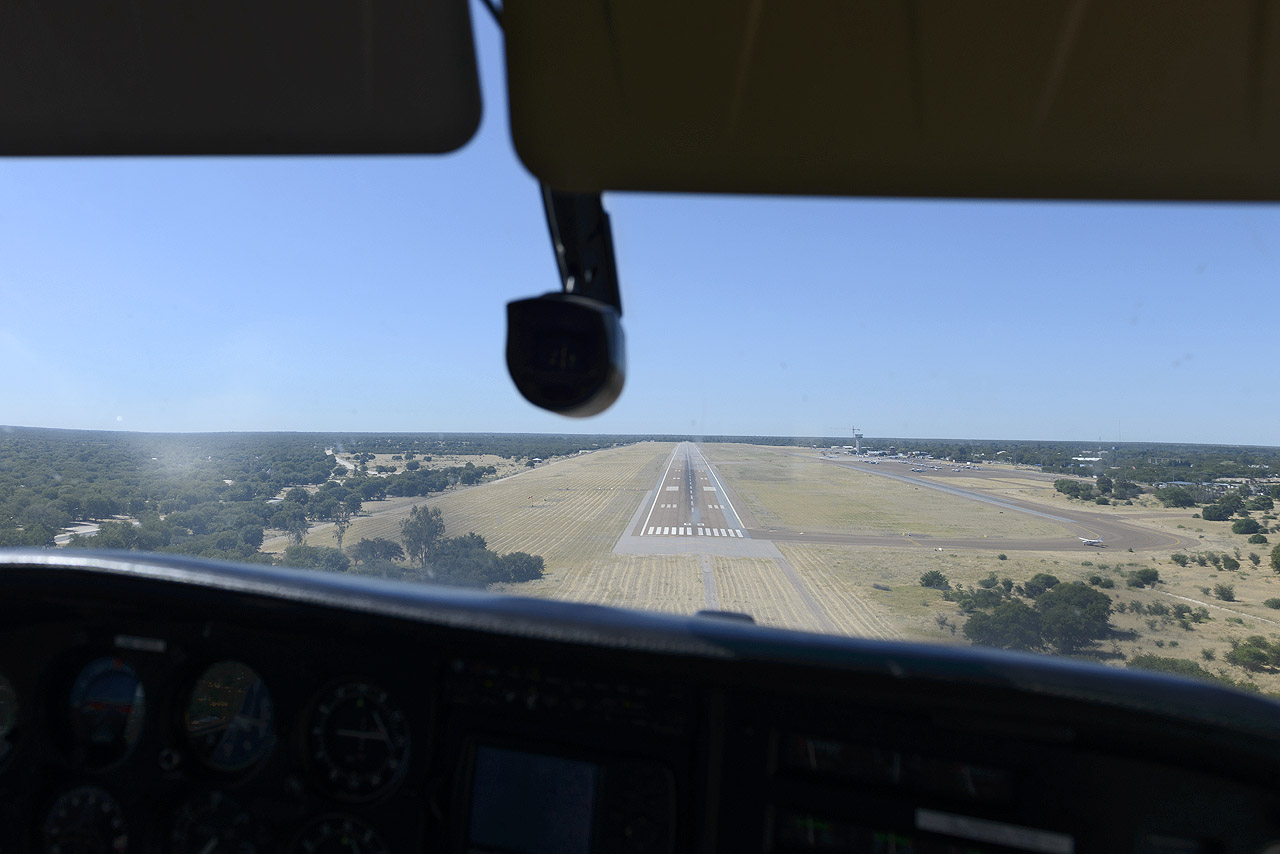
Basic Information
Individual journey. The journey will be planned on your preferred dates.
Duration 10 nights. Min 2 guests. Minimum age 6 years. Weight limit of luggage 20 kg. Luggage in one soft bag only.
Includes all transfers from Maun to the hotels/camps to Maun
- Tau Pan Camp: Standard Room. All meals, drinks (except premier brands), twice daily shared activities with one of the camp guides.
- Little Vumbura Camp: Standard Room. All meals, drinks (except premier brands), laundry service, twice daily shared activities with one of the camp guides.
- Kings Pool: Standard Room. All meals, drinks (except premier brands), laundry service, twice daily shared activities with one of the camp guides.
- Mombo & Little Mombo: Standard Room. All meals, drinks (except premier brands), laundry service, twice daily shared activities with one of the camp guides.
Learn more about these areas











